Click on images to enlarge

infestation (Photo: Greg Jordan)
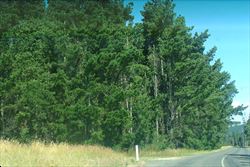
forestry plantation (Photo: Sheldon Navie)
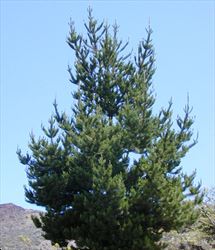
habit (Photo: Forest and Kim Starr, USGS)
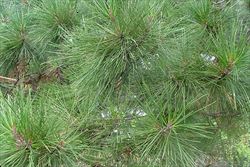
branches with leaves (Photo: Sheldon Navie)
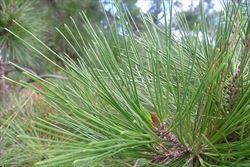
elongated needle-like leaves (Photo: Sheldon Navie)
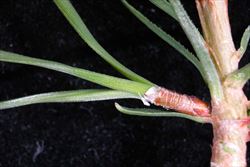
close-up of sheath and base of leaves, which are usually grouped in threes (Photo: Greg Jordan)
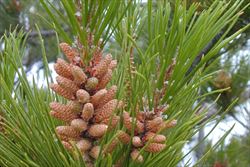
dense clusters of male cones (Photo: Forest and Kim Starr, USGS)
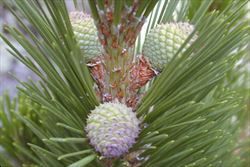
young female cones (Photo: Forest and Kim Starr, USGS)
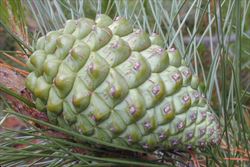
immature female cone (Photo: Forest and Kim Starr, USGS)

assymetrical mature female cone (Photo: Sheldon Navie)
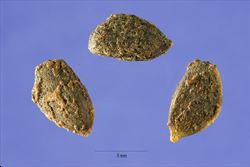
close-up of seeds after their wings have been removed (Photo: Steve Hurst at USDA PLANTS Database)
Scientific Name
Pinus radiata D. Don.
Synonyms
Pinus insignis Douglas ex Loud.
Family
Pinaceae
Common Names
insignis, insignis pine, Monterey pine, radiata, radiata pine, wilding pine
Origin
Native to south-western USA (i.e. Monterey County in California) and north-western Mexico.
Cultivation
This tree is widely cultivated in plantations for its timber and is also grown as an ornamental in parks and gardens.
Naturalised Distribution
Widely naturalised in southern and eastern Australia (i.e. in the cooler parts of south-eastern Queensland, on the tablelands regions of eastern New South Wales, in the ACT, in Victoria and Tasmania, in south-eastern South Australia and in south-western Western Australia.
Also naturalised in southern Africa, New Zealand, southern South America and on several Pacific islands (e.g. Hawaii and the Galápagos Islands).
Habitat
Radiata pine (Pinus radiata) has become naturalised in the southern and eastern parts of Australia, particularly near forestry plantations, and is a weed of roadsides, urban bushland, open woodlands, disturbed sites and waste areas.
Habit
A large tree growing to 30 m tall.
Distinguishing Features
- a tree with dark brown bark that is deeply ridged.
- its needle-like leaves (7.5-15 cm long) are grouped in threes and enclosed within a sheath at their base.
- its 'cones' are obliquely egg-shaped.
Stems and Leaves
The bark is dark brown in colour with deep ridges.
The needle-like leaves (7.5-15 cm long) are dark green, rigid, and have a pointed tip (i.e. acute apex). They are grouped into threes an their bases are enclosed in a persistent sheath (5-15 mm long). These leaves are shed as a group, with the sheath intact, after three or four years.
Flowers and Fruit
This species produces separate male and female reproductive structures (i.e. cones) on the same plant. The male cones are cylindrical (1-1.5 cm long) and clustered at the tips of the branches. The much larger female cones (7-17 cm long and 6-8 cm wide) are borne on short stalks and are often clustered together. They are lop-sided in shape, with the outer side of the cones being larger than the inner side. These female cones often remain unopened for some years and their glossy scales are greyish brown in colour, with a tiny prickle at the tip.
The seeds are blackish in colour, oval in shape (i.e. ellipsoid) and about 6 mm long, with a papery wing up to 2.5 cm long.
Reproduction and Dispersal
This species reproduces by seed. The seeds are mostly spread by wind and water, though they may also be dispersed by birds (e.g. cockatoos) and in dumped garden waste.
Environmental Impact
Radiata pine (Pinus radiata) is regarded as a significant environmental weed in Victoria and South Australia, and as an environmental weed in New South Wales, the ACT, Tasmania, Queensland and Western Australia. It is actively managed by community groups in South Australia, Victoria and the ACT, and in listed as a priority environmental weed in three Natural Resource Management regions.
Legislation
This species is declared under legislation in the following states and territories:
- ACT: C3 - a pest plant that must be contained.
- Western Australia: Unassessed - this species is declared in other states or territories and is prohibited until assessed via a weed risk assessment (throughout the entire state).
Similar Species
Radiata pine (Pinus radiata) is similar to many other pine species that have become naturalised in Australia, including slash pine (Pinus elliottii), Caribbean pine (Pinus caribaea), cluster pine (Pinus pinaster) and Aleppo pine (Pinus halepensis). These species can be distinguished by the following differences:
- radiata pine (Pinus radiata) has relatively large asymmetrical cones (7-17 cm long) that are borne on short curved stalks. Its leaves are relatively short (8-15 cm long) and usually borne in groups of three (rarely in twos).
- slash pine (Pinus elliottii) has relatively large symmetrical cones (7-20 cm long) that are borne on short stalks. Its leaves are relatively long (15-30 cm long) and borne in groups of two or three (usually in twos).
- Caribbean pine (Pinus caribaea) has relatively small symmetrical cones (5-12 cm long) that are borne on short stalks. Its leaves are relatively long (15-30 cm long) and usually borne in groups of three (rarely in twos, fours or fives).
- cluster pine (Pinus pinaster) has relatively large slightly symmetrical or asymmetrical cones (9-20 cm long) that are almost stalkless (i.e. sessile). Its leaves are relatively long (10-30 cm long) and usually borne in groups of two.
- Aleppo pine (Pinus halepensis) has relatively small symmetrical cones (5-14 cm long) that are borne on curved stalks 10-30 mm long. Its leaves are relatively short (4-12 cm long) and usually borne in groups of two.

